Darkfield photography reveals hidden details by positioning light behind subjects against a black background. You’ll capture only light that interacts with your subject, creating a luminous glow effect that highlights edges and textures. Place your light source behind a black gobo, adjust distances to control edge hardness, and experiment with angles to maximize detail. For glass or reflective objects, use side baffles to manage unwanted reflections. These simple techniques transform ordinary subjects into magical, glowing specimens before your eyes.
9 Second-Level Headings for “Darkfield Photography: Illuminate Hidden Details Like Magic”
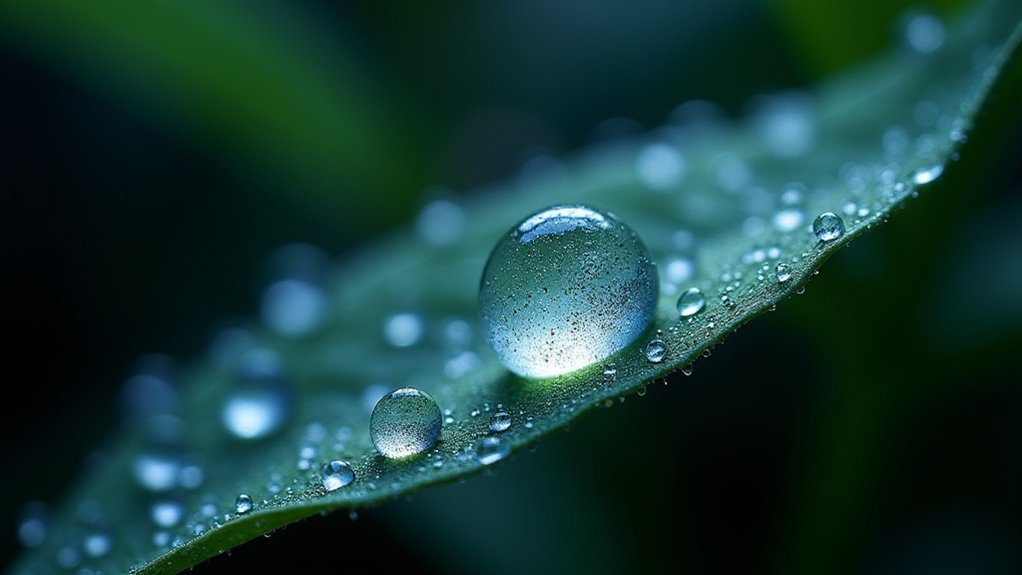
When organizing your darkfield photography article, you’ll need clear second-level headings that guide readers through this specialized technique.
Consider sections like “Understanding Dark Field Lighting Basics,” which explains positioning your light source behind subjects with the essential dark patch that creates the dramatic black background.
Include “Setting Up Your Light Source,” detailing how to position large diffusers and adjust distances to control edge hardness.
Add “Managing Reflections with Baffles,” showing readers how to prevent light spill that ruins the effect.
Don’t forget “Photography Lighting Techniques for Transparent Objects,” explaining how grazing light reveals textures on glass and reflective surfaces.
Finally, include “Product Photography Applications,” demonstrating how this technique showcases intricate details in commercial work, turning ordinary items into stunning visual displays with enhanced textures.
The Science Behind Darkfield Illumination
Darkfield illumination creates its dramatic effect through a simple but ingenious optical principle: light rays strike your subject at such oblique angles that they don’t enter your lens unless redirected by the subject itself.
You’ll notice this technique transforms transparent subjects into luminous objects against a pitch-black background, fundamentally highlighting edges where light changes direction due to diffraction and scattering.
The stark contrast between light and dark occurs because only the light interacting with your subject reaches the camera sensor, while the background remains unilluminated, creating that characteristic “glow” around subject edges.
Dark Vs Light
Unlike traditional brightfield microscopy, darkfield illumination operates on a fascinating optical principle that inverts our typical viewing experience. While brightfield uses even light passing directly through specimens, darkfield blocks central rays and only allows oblique light to interact with your sample, creating a striking dark background effect.
| Feature | Brightfield | Darkfield |
|---|---|---|
| Background | Bright white | Deep black |
| Specimen appearance | Absorbs light | Scatters light brilliantly |
| Detail visibility | Limited for transparent objects | Enhanced for transparent structures |
You’ll notice the dramatic difference when comparing these lighting techniques. The dark background makes previously invisible specimens appear to glow against the darkness. This contrast transformation reveals intricate structures of transparent organisms that would otherwise blend into brightfield’s even light, making darkfield illumination invaluable for observing living microorganisms in their natural state.
Edge Highlight Physics
The magic of darkfield imaging emerges from a fascinating interplay of light physics that transforms ordinary specimens into luminous objects.
When you position high intensity light behind the subject at oblique angles, you’re creating perfect conditions for revealing what’s typically invisible.
The technique works by exploiting differences in refractive indices. As grazing light rays interact with your specimen’s surface, they’re scattered toward your lens, creating striking edge lighting effects against a dark background.
You’ll notice transparent subjects suddenly gain definition and contrast without overwhelming artifacts.
Essential Equipment for Mastering Darkfield Techniques
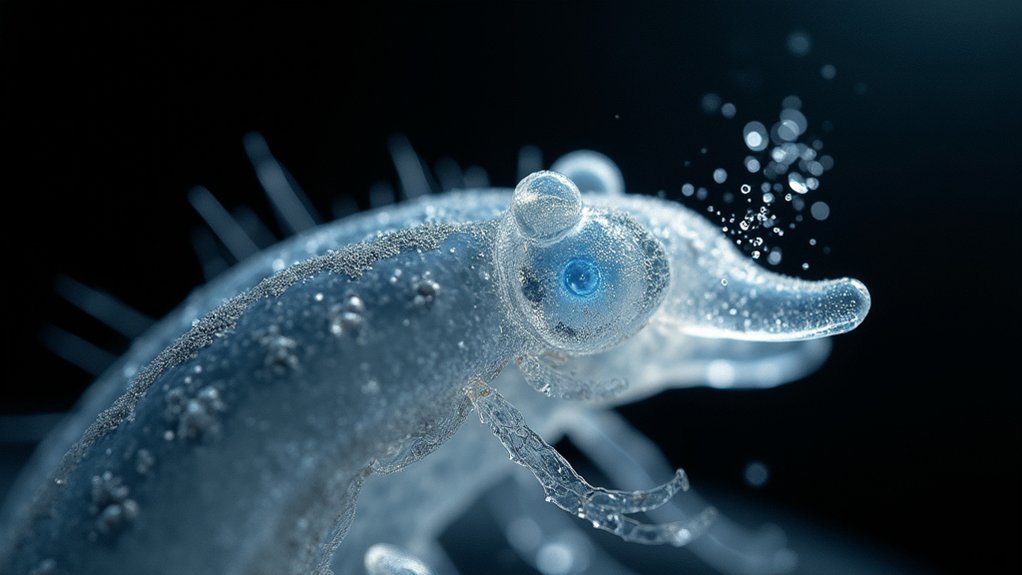
To successfully venture into darkfield photography, you’ll need several specific pieces of equipment that work together to create that distinctive edge-lit effect against a dark background. Position a table lamp or soft-box behind a black gobo to block direct light from reaching your subject. Use black card or velvet to absorb excess light, ensuring only grazing light highlights your subject’s edges.
| Equipment | Purpose | Effect |
|---|---|---|
| Light source | Provides illumination | Creates different looks depending on intensity |
| Black gobo/card | Blocks direct light | Enhances dramatic contrast |
| White reflectors | Bounces light onto subject | Highlights edges and textures |
For best results, try a Canon EOS 1Ds Mark II with a 70mm lens at f/13, 1/250 sec. Experiment with distances between your light, gobo, and subject to achieve perfect edge lighting.
Setting Up Your Darkfield Photography Studio
Creating an effective darkfield setup requires careful positioning of your light sources and modifiers to achieve that distinctive edge-lit effect.
Begin by placing a large light behind a black gobo to block direct illumination, guaranteeing only grazing light hits your subject’s edges. Position white reflectors on both sides to bounce light back onto your subject, revealing details while maintaining dramatic contrast.
- Position your black gobo between the light source and subject to block direct light
- Place two white reflectors in front and to the sides to bounce light onto edges
- Adjust the distance between your large light and subject to control edge hardness
- Confirm the gobo effectively blocks light from passing through transparent objects
- Experiment with different angles and positions to highlight specific textures and details
Controlling Light Spill and Managing Reflections
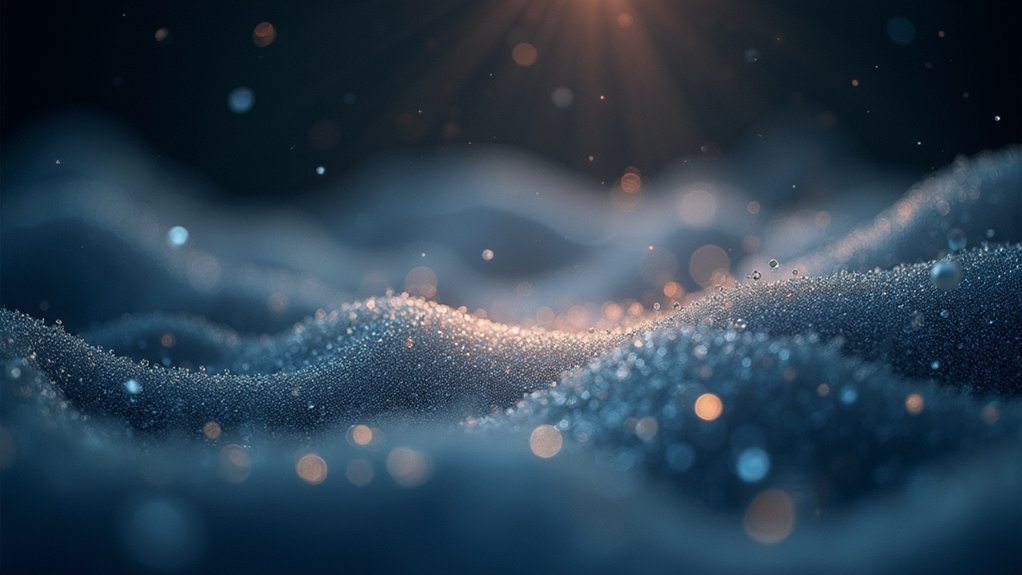
Mastering light spill control is critical in darkfield photography, where you’ll need to position black gobos strategically and adjust your light source’s distance to achieve the perfect grazing effect while maintaining a dark background.
You can employ aperture flags to direct light precisely where needed, preventing lens flare that would compromise your high-contrast images.
Side baffles and top caps will help you manage unwanted reflections, especially when photographing glass or reflective objects that might otherwise capture stray light.
Light Management Basics
While artistic vision drives darkfield photography, technical light control makes or breaks your final image. Effective light management requires understanding how to control light spill and position your equipment strategically.
Photographers can use several techniques to achieve striking darkfield results:
- Adjust your light source size or reposition black gobos to guarantee only grazing light reaches your subject.
- Install aperture flags to prevent lens flare and direct light precisely where needed.
- Add side baffles and top caps to eliminate unwanted reflections, especially when shooting glass or transparent objects.
- Experiment with light-to-subject distance to modify edge hardness and incidence angles.
- Thoroughly clean your subject before shooting to prevent dust and smudges from disrupting light reflections.
Mastering these fundamentals will dramatically improve your darkfield photography, revealing textures and details invisible to conventional lighting techniques.
Reflection Control Tools
Effective darkfield photography hinges on your ability to tame and direct light with precision.
Side baffles and top caps are essential reflection control tools that manage unwanted reflections when working with transparent or highly reflective subjects. You’ll find aperture flags invaluable for blocking light spill that causes lens flare, dramatically enhancing subject detail clarity.
Adjust the distance between your light source and black gobo to control edge hardness of light emitted onto different materials.
For balanced illumination without compromising the dramatic darkfield effect, position white reflectors strategically to bounce light back onto shadow areas.
Don’t hesitate to experiment with angles and positions of your reflection control tools—this exploration often reveals unique lighting effects that emphasize textural details while maintaining that striking black background that defines the darkfield technique.
Subject Positioning and Rotation for Optimal Results
The success of darkfield photography often hinges on how you position your subject relative to the light source. By placing your subject at varying distances from the light, you’ll dramatically alter how light grazes surfaces, revealing textures invisible to the naked eye.
You’ll need to experiment with different angles to light effectively, rotating your subject to catch those perfect highlights that make darkfield images so striking.
- Move your subject closer or farther from light sources to change the angle of incidence
- Rotate your subject gradually to discover which orientation reveals the most detail
- Adjust positioning to manage reflections, especially with glass or shiny materials
- Try unconventional angles to highlight features missed in standard lighting
- Combine subject rotation with light repositioning for the most dramatic results
Photographing Glass and Transparent Objects
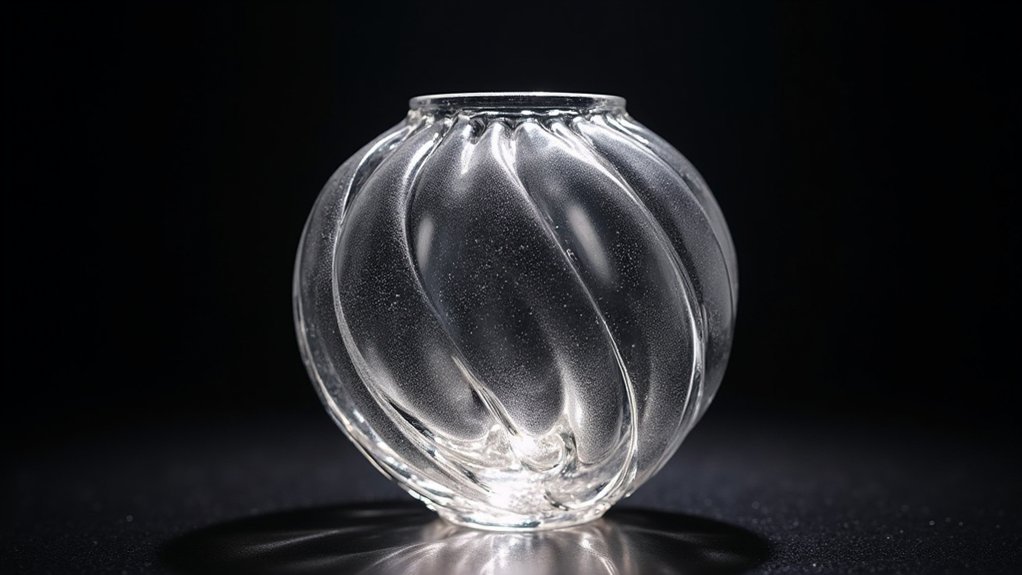
Few subjects showcase the magic of darkfield photography quite like glass and transparent objects. When you position your lighting behind a black gobo, you’ll create a stunning effect where only the edges of the glass catch the light against a deep black background. This technique reveals intricate surface textures without the distracting reflections that plague traditional lighting methods.
Try working with a narrow strip of light that grazes the object’s surface, creating dramatic edge highlights that emphasize its form. You can greatly alter the visual impact by adjusting the distance and angle of your light source.
Don’t forget to incorporate white reflectors to bounce controlled light back onto the glass, gently filling shadows and adding subtle highlights that enhance the object’s dimensional qualities.
Revealing Textures in Flat Surfaces and Materials
While glass objects showcase darkfield photography’s three-dimensional potential, flat surfaces reveal an entirely different kind of magic.
By positioning a large light source behind your subject, you’ll create grazing illumination that accentuates every ridge, scratch, and texture. The contrast between the black background and the illuminated edges transforms ordinary materials into spectacular visual studies.
- Position your subject between your camera and the light source for maximum texture definition
- Use a black card behind flat objects to enhance contrast and eliminate unwanted reflections
- Experiment with light angles to reveal different textural elements even around the edges
- Metal, paper, fabric, and wood all respond dramatically to darkfield techniques
- Adjust the distance between light and subject to control the intensity of texture highlights
Creative Applications of Darkfield Photography
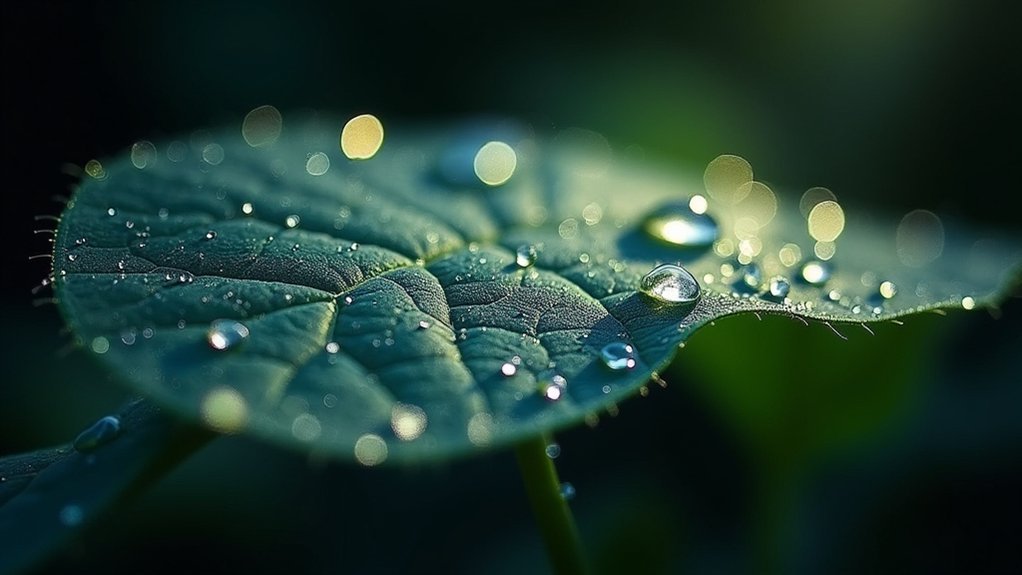
Beyond its technical applications, darkfield photography offers limitless creative possibilities for photographers willing to experiment. You’ll find that using a large light source behind a black gobo creates dramatic presentations that highlight the interplay of light on various surfaces.
| Subject | Effect | Creative Use |
|---|---|---|
| Jewelry | Edge highlighting | Dramatic product shots |
| Glassware | Enhanced transparency | Revealing invisible details |
| Metals | Surface texture emphasis | Artistic texture studies |
Try adjusting the distance and angle of your light source to dramatically alter visual impact. This technique isn’t just for product photography—it’s perfect for artistic exploration that builds mood and depth in your images. Experiment with skin textures, dynamic light interplay, and other subjects to discover how darkfield photography can transform ordinary surfaces into extraordinary visual experiences.
Frequently Asked Questions
What Is Magic Light in Photography?
Magic light in photography is when you position light behind your subject with a dark patch blocking direct illumination. It’s a technique that reveals textures and details you can’t see with standard lighting.
How Does Dark Field Lighting Work?
Dark field lighting positions a large light source behind your subject with a blocking patch in the middle. You’ll capture only grazing light that highlights edges and textures, creating a striking black background that reveals subtle details.
In Summary
You’ve now discovered the enchanting world of darkfield photography. With the right setup and techniques, you’ll reveal hidden details invisible to the naked eye. Don’t be afraid to experiment with different subjects and lighting angles—that’s where the magic happens. As you continue to refine your skills, you’ll transform ordinary objects into extraordinary visual experiences. The unseen world awaits your artistic vision.

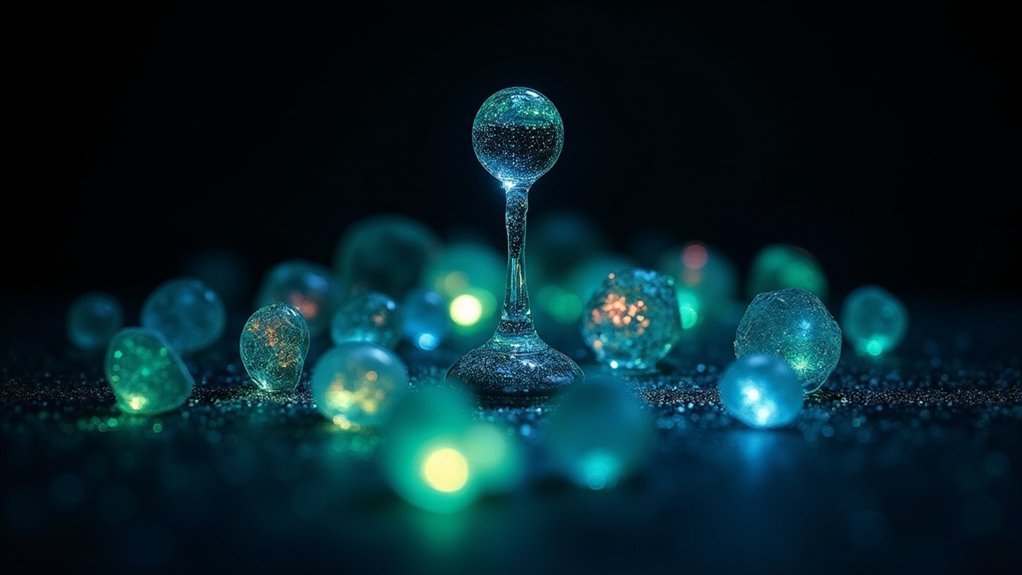



Leave a Reply